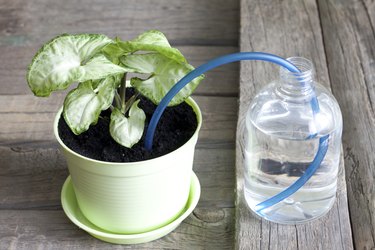
A self-watering planter provides consistent moisture for its plants and works especially well for vegetables, tropical plants and other plants that require moist soil. Most self-watering planters don't require the addition of water daily. Because self-watering planters' styles vary, understanding basic information about them will help you grow plants in them successfully.
Subirrigation Design
Video of the Day
A self-watering planter with a bottom water reservoir is referred to as a subirrigation planter. It features an empty space in its bottom that can hold water; soil sits above the reservoir. Holes in the divider between the soil compartment and water reservoir, along with wicking chambers that extend into the water reservoir, allow moisture to move from the reservoir to the soil without making the soil too wet. The planter's fill tube is used to add water to the reservoir. The planter also may have an overfill hole that allows excess water to drain if the container is overfilled. The reservoir needs refilling at one- to five-day intervals, depending on its size, the planter's size and whether the planter is kept indoors or outdoors.
Video of the Day
Outside-Reservoir Type
The reservoir of a wicking-style self-watering planter sits outside the planter. That reservoir -- a bucket or jug of water -- sits above the level of the planter, and a cotton wick runs from the reservoir's water into the planter's soil. The soil draws water from the reservoir through the wick as the soil dries. This style of planter is usually homemade. The wick can be a strip of cotton cloth, such as from a T-shirt, and the setup is suitable for any kind of plant container. An outside-reservoir, wicking-style self-watering planter works well for turning a regular planter temporarily into a self-watering model; for example, it can be used when you are on vacation. The reservoir's water level is simple to monitor in this design because the reservoir is outside the planter.
Container Selection
Manufactured subirrigation planters come in a variety of styles and sizes, which makes them suitable for indoor potted plants, outdoor ornamentals and container vegetable gardens. Larger planters can be used to grow multiple plants while 6- to 10-inch planters work well for single plants. Hanging basket subirrigation planters are also available, but use them only if you have a sturdy hanging spot because the reservoir water gives them additional weight. Ensure the planter you use has an easily accessible fill tube and an overfill hole. Some planters have a lipped slot for filling water near their bases, and the lipped slot doubles as the overfill hole.
Tips and Timing
Drainage isn't an issue in a self-watering planter because the soil absorbs only the water it needs. A drip tray may be needed beneath the planter to catch spills from the overfill hole, though. After planting in a self-watering planter, water its soil from the top -- the soil surface -- for the first seven to 14 days, until the plants' roots are established sufficiently to begin drawing water from the planter's reservoir. Add a small amount of water to the reservoir each day. If water comes from the overfill hole, then the plants still require some watering from the soil's top. When the water level in the reservoir begins to go down, you can stop watering the soil from the top and only fill the reservoir with water.